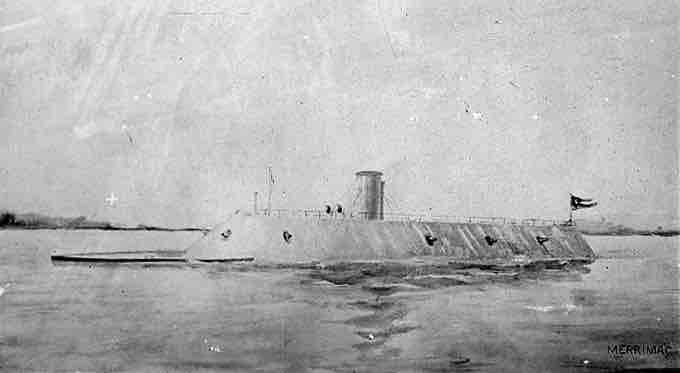Naval Actions During the Civil War
The first shots of the naval battles of the Civil War were fired on April 13, 1861, during the Battle of Fort Sumter, by the Revenue Service cutter USRC Harriet Lane. The final shots were fired in the Bering Strait by the Confederate raider CSS Shenandoah, on June 22, 1865, more than two months after General Robert E. Lee's surrender of the Confederate Army.
Both the Union and Confederate navies started the Civil War with small, ill-purposed fleets, but they made impressive innovations in naval technology during the war, setting the stage for the next generation of warships. Over the course of the war, both sides' navies grew and possessed increasingly well-developed technology. For example, the Civil War saw the first clash of ironclad warships. Though neither the Union nor the Confederates began the war with ironclads in their arsenals, the Confederacy moved quickly to obtain ironclads from overseas to gain a competitive advantage. On October 12, 1861, the CSS Manassas entered combat against Union warships on the Mississippi during the Battle of the Head of Passes. By March 9, 1862, the Union ironclad Monitor entered a fray with Confederate warships, marking the first-ever clash between two ironclad ships. Both sides continued to build ironclads for use in the war, with many of the Union ironclads seeing action in Confederate ports and in the rivers along the western front. The Union ironclads were particularly effective along the Mississippi and its tributaries where they were able to direct heavy fire against Confederate forts and strongholds with limited return fire.
By the end of 1861, the Union Navy had grown to 24,000 officers and enlisted men, over 15,000 more than during the antebellum period. Four squadrons of ships were deployed during the war: two in the Atlantic and two in the Gulf of Mexico. The primary missions of the Union Navy were to accomplish the following:
- Maintain the blockade of Confederate ports by restraining all blockade runners as declared by the president on April 19, 1861.
- Meet in combat the war vessels of the Confederate States Navy.
- Carry the war to places in the seceded states that were inaccessible to the Union Army but could be reached by water.
- Support the Union Army by providing both gunfire support and rapid transport and communications on the rivers of the interior.
The Union Blockade, or the Blockade of the South, took place between 1861 and 1865. President Abraham Lincoln proclaimed the blockade on April 19, 1861. His strategy, part of the Anaconda Plan of General Winfield Scott, required the closure of 3,500 miles of Confederate coastline and 12 major ports. These included New Orleans, Louisiana; and Mobile, Alabama, the top two cotton-exporting ports prior to the outbreak of the war, as well as the Atlantic ports of Richmond, Virginia; Charleston, South Carolina; Savannah, Georgia; and Wilmington, North Carolina. The Union commissioned 500 ships to enforce this blockade, and they destroyed or captured approximately 1,500 blockade runners over the course of the war. Confederate "blockade runners" that did manage to get through the blockade carried only a small fraction of the usual cargo.
Early battles in support of the Anaconda Plan included the Blockade of the Chesapeake Bay (May–June 1861) and the Blockade of the Carolina Coast (August–December 1861). Both enabled the Union Navy to gradually extend its blockade southward along the Atlantic seaboard. As the Union fleet grew in size, speed, and sophistication, more ports came under federal control. After 1862, only three ports—Wilmington, North Carolina; Charleston, South Carolina; and Mobile, Alabama—remained open for the 75 to 100 blockade runners still operating. Charleston was shut down by Admiral John A. Dahlgren's South Atlantic Blockading Squadron in 1863. Mobile Bay was captured in August 1864 by Admiral David Farragut. Blockade runners faced an increasing risk of capture—in 1861 and 1862, one ship in nine was captured; in 1863 and 1864, this number increased to one in three. By war's end, imports had been choked to a trickle as the number of captures increased to about 50 percent of Confederate ships.

The CSS Virginia
The CSS Virginia was the Confederate's ironclad warship. It met with great success at the Battle of Hampton Roads despite being the target of most of the Union's firepower. It famously dueled with the USS Monitor, signaling the beginning of a new age of ironclad naval combat.